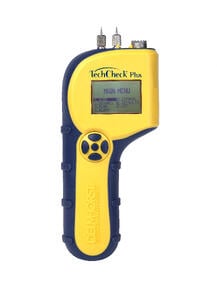Restoration experts have to be extraordinarily thorough in their efforts to locate and remediate excess moisture in structures. If the source of moisture intrusion or a pocket of moisture is missed, it can cause damage to a building well after the restoration is “finished.” This can lead to return issues, complaints, and even demands for money back.
So, to make sure that your own restoration work is as thorough as possible, you need the best methods to detect excess moisture. However, which methods are the best for making a fast and thorough search for moisture in a structure?
Visual/Olfactory Searches
While perfectly fine for finding some of the most obvious sources of moisture intrusion or the largest surface-level pockets of moisture, sight and smell are rarely enough on their own. Hidden moisture pockets deep in wood flooring, insulation, and other building materials can be practically invisible, making them very easy to miss.
Thermo-Hygrometers
Thermo-hygrometers are a staple tool of many professionals in the restoration industry. While these tools cannot pinpoint the presence of excess moisture in building materials, they can help verify that the ambient humidity conditions in the structure are in an acceptable range.
Following a flood or other water damage event, the humidity in a structure will increase immensely. This increases the risk of wood and other hygroscopic materials absorbing moisture from the air—leading to swelling and other moisture-related problems.
Thermo-hygrometers are used to check the relative humidity (RH) in a given area. Restoration experts often check RH in different rooms of a structure to narrow down the rooms that most need dry-out/tear-out work. If one room has a high RH compared to the rest, then the odds are that there is a significant pocket of moisture or moisture intrusion source located there.
After the restoration job is finished, you could even use RH meter readings to show how much you’ve dried out the structure to clients—creating evidence of the quality and thoroughness of your work to prevent future disputes.
Moisture Meters
Hands down, moisture meters are the best tool you can have at your disposal when trying to thoroughly inspect a structure for hidden moisture pockets. However, there are a lot of different kinds of moisture meters of varying speed and accuracy.
Some meters use electrodes to pass a current through building materials, while others use electromagnetic frequencies to scan for moisture. Moisture meters may have different reading scales for testing wood, drywall, or other building materials—some may even be able to switch from one reading scale to another as needed.
A few high-quality meters may even have special probe sockets to let you use additional probes for checking moisture in areas where standard pins or scanning plates might not be able to get a reliable reading. For example, the 19-E/STC probe from Delmhorst has flat blades that are ideal for getting behind trim and baseboard molding, while the extra-long 1235 and 830 series prods can reach deep in insulation to check for moisture safely.
Which of these moisture meters is the best for detecting excess moisture in restoration work?
 For the absolute best speed and accuracy in a single device, you’ll probably want to use a 2-in-1 moisture meter, such as the TechCheck PLUS, which has both pin and pinless testing modes and a universal probe socket (attachable to any Delmhorst probe).
For the absolute best speed and accuracy in a single device, you’ll probably want to use a 2-in-1 moisture meter, such as the TechCheck PLUS, which has both pin and pinless testing modes and a universal probe socket (attachable to any Delmhorst probe).
The pinless scanning mode allows you to quickly check for moisture in many different building materials. Once moisture is found, the pins are great for determining how deep the moisture pocket is. The probe socket allows you to use specialized electrodes for checking moisture conditions in hard-to reach areas.
By far, high quality moisture meters are the fastest, most reliable tool for measuring moisture in restoration. They provide accurate, quantifiable measurements of moisture in building materials so that you can make more informed decisions regarding your dry-out/tear-out work, and demonstrate the necessity of your work to your clients.

Comments